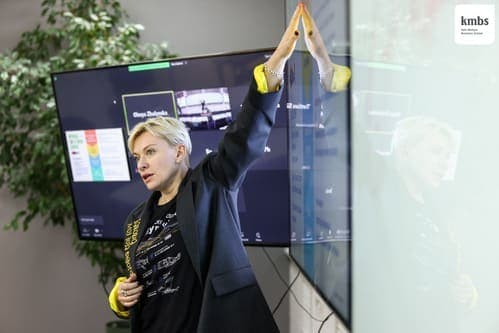Learn first
KMBS latest news in real time

For the latest KMBS events and news, visit KMBS Live at the top right corner of the screen
Open kmbs live 09.11.2023
09.11.2023 1123
1123 0min
0minWhy is there a surge of interest in pricing models right now? And which models are now in focus?
Yevhen Pentsak: These processes are not happening in Ukraine by chance; they started a long time ago. Analytics is an integral decision-making tool for company managers. Analytics is about making data speak. But the question arises: how can team motivation, leadership, and analytics be combined?
Mckinsey recently published an interesting article with the former head of Societe Generale, Frederic Udea, about implementing solutions in a company. He says that even if you have already built a team and trust in it, but you do not have keys, then this team will be ineffective. Analytics helps make decisions. When you know how to analyze customer behavior, understand what is happening in the market, catch trends first, and learn how to work with big data, with innovative tools based on blockchain, artificial intelligence, etc. - this is an opportunity to be a market leader.
If we talk about pricing, then the answer to the question "Why is it becoming relevant now?" may lie in the plane of technology. Namely, work with large volumes of data, fast calculations in the cloud, and quick implementation of the results of these calculations in real business. There were no such opportunities before.
Once, we wanted to manage store formats, but then we realized that we were not actually managing stores, but the flow of people, and their experience. So, we need a tool to measure these data - characteristics of points of sale, characteristics of the customer base, loyal customers, etc. And then, you need to process this data and turn it into information. This is precisely what the models are talking about: behavioral, information economy, and analytical models.
But at the same time, the company's culture is also essential, the ability to ask the right questions, to understand how well you make decisions, and to modify them. We have to try, and maybe make mistakes, but based on our actions and changes in the behavior of our customers, we make more and more effective decisions.
We also need to understand the horizon of our planning. Do we want short-term solutions like increasing profits? But you can increase the gain so much that no one will visit the store anymore. Therefore, you still need to understand how you will act in the future. For example, what gamification processes will you launch for customers? After all, we are actually children. We like to play games, we are emotional. Therefore, elements of behavioral economics should also underlie modern pricing models. I call them differential-algorithmic pricing models.
These models are a kind of rules of the game, and the rules are different, more or less effective. We need to develop the best practices for us, and to do that; we need metrics to determine which model works best.
It is not so simple, because human behavior changes quickly, especially under the influence of social networks and other factors that are not obvious at first glance. This is where big data and differentiated pricing come to the rescue.
Differentiated pricing is an individualized approach to each point of sale, to customers who visit a particular store, and often to each buyer. This approach allows you to understand what the buyer likes (taking into account his purchase history), which marketing communications should be launched, and which customer segment should be transferred to (which piece brings the most utility in the long term).
And how to properly approach such pricing? What should be taken into account?
Yevhen Pentsak: Each analysis begins with a descriptive part. Let's say, if we are talking about a chain of stores - it is necessary to analyze what financial and economic traces it left behind, under what conditions did it work? We live in a very turbulent time right now, so when we receive data, we often see unpredictable behavior patterns. And we cannot bypass them until we understand the reason.
However, if an ordinary economist thinks only about explaining past behavior, then a practicing analyst thinks about predicting it. That is, we are already moving to predictive analytics. We see what sales or other indicators we can expect if nothing changes in the company - and at the same time, we start thinking about what changes should be implemented to achieve better results.
In physics and other sciences, you can do experiments and repeat them many times. But we do not have such a privilege in business, because there may not be enough time for the subsequent investigation. That is why we need modeling - so that at the level of a model that nicely explains the previous behavior of our business, we could see how to manage this system differently and what the result would be. There are technologies (for example, Monte Carlo simulations) that allow us to generate millions of scenarios under which our business may develop, and to understand the average picture - what the results of a particular management decision will be.
What does differentiated pricing look like in practice?
Yevhen Pentsak: Previously, a typical scheme of retail work looked like this. Stores purchased goods that they considered to be in demand by consumers. Retail also conveys to manufacturers wishes from consumers (what attributes of the product should be changed so that the willingness to pay for it becomes higher).
Retail also has marketing departments that deal with pricing, look at the direction of competitors and the market, research consumer behavior, and come up with innovations. They promote these innovations through their own marketing channels.
Manufacturers have always reasoned like this: the distributor will take his margin (say, 5-10%), and the retailer - his (for example, 20%). So, this product will appear on the consumer's shelf at such and such a price, if our selling price is like this.
However, consumers who visit stores have different purchasing power, roles, and needs. And not all of them are willing to pay the same price for the same product, as traditional pricing suggests.
Another problem of undifferentiated pricing is the presence of a large number (according to various estimates, from 20 to 120) of non-price factors that influence consumer behavior. Sometimes, it seems to company managers that there is an obvious connection: if I increase the number of parking spaces, sales will increase; if I supply a coffee machine, sales will increase. But in reality, this is not always the case: at some points, one action must be taken, and at others - another. But how do you know where and what to do when you manage not one small store near your home, but 100 or 500 stores?
So, how do you understand it?
Yevhen Pentsak: This requires special analytical tools, more complex than the econometric analysis studied at the university. And for this, it is worth exploring business analytics - because it comes at different levels. For example, in the MBAF program, we study advanced tools, learn to develop a business model and simulate the behavior of all stakeholders, and understand modern analytical methods, which are based on understanding which software should be used and how to integrate different tools.
A skilled analyst should listen to the ideas of the company's leaders and understand which tool and software to use to evaluate the effect of its implementation. But this does not mean that he should only use ready-made tools. A good analyst should develop his own tool that will best "catch" the manager's idea and give it not only a qualitative and quantitative assessment.
What requests regarding analytics are currently the most relevant for the heads of Ukrainian companies?
Yevhen Pentsak: When a Ukrainian company enters international markets and seeks to attract investments, it often faces the fact that it is not understood there: neither its messages nor its financial and economic indicators. When our managers are asked what are the levers of influence for increasing capitalization, they answer that they never thought about it, because they reasoned in the short term: the more we sell, the better.
But if you want to be a world-class player, you have to think like a world-class player. Investors want to be sure that success and stable development await your company. You must have a full-fledged management toolkit, including an analytical component. In particular, we need tools for management options, corporate analytics, risk management, factor analytics, customer analytics...
For each task that the business solves, the analyst must create a clustering model, a segmentation model, a customer analytics model, a marketing communications model, and a dynamic pricing model, and also determine metrics that measure the effectiveness of implemented solutions. After all, the company's management wants to know what worked and with what force.
Why learn advanced analytics tools at all?
Yevhen Pentsak: Today's business is changing so rapidly that if you don't plan, if you don't prepare for the future, life will return in its own way, and you will be unprepared for specific scenarios. However, companies that can create a culture of analytical thinking survive and become leaders.
They already know how to start solving the task or problem facing the business, understand what factors and how exactly they affect the result, what tool and metric should be used to solve management problems, how to build a model and simulate what will happen in the future , and how to choose the best course of action.
There is one "toolbox" for short-term solutions, and another for long-term solutions. Of course, we cannot plan everything, but the broader range of analysis tools we have, the faster we will make decisions when needed. If you start thinking about the influencing factors at the moment of the problem, you just start thinking about the influencing factors, then everyone around you will be ahead of you.
And what do you recommend reading to increase your awareness of business analytics?
Yevhen Pentsak: Now, you can follow trends through articles. For example, since the beginning of October, dozens of articles began to appear about how weight loss drugs will affect various industries (the packaging, insurance, etc.). This field already sells medications for $3 billion a year, and by 2023, the figure may grow ten times. The use of such drugs reduces the volume of food consumption by about 30%. Therefore, both the market for food and alcohol can be significantly reduced.
This will likely be a game changer, which has not been in the pharmaceutical market for many years. And companies that use an analytical approach think: how will other businesses and industries change? And what should we do with all this?
To miss such a trend is to get caught, because when something new appears on the market, it is an opportunity for analytics to show its full power. As they say, turbulence, and crisis is not only a threat, but also an opportunity to bypass the closest competitors at this turn.










